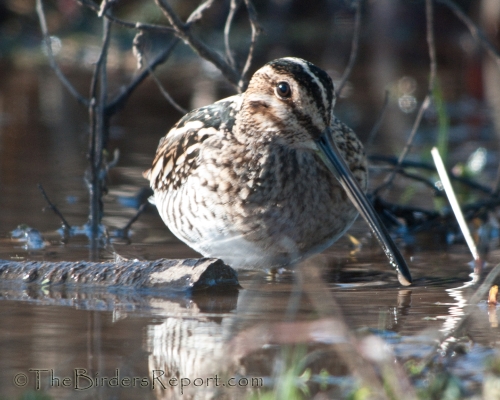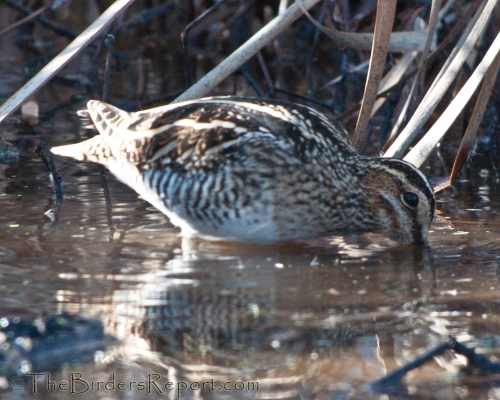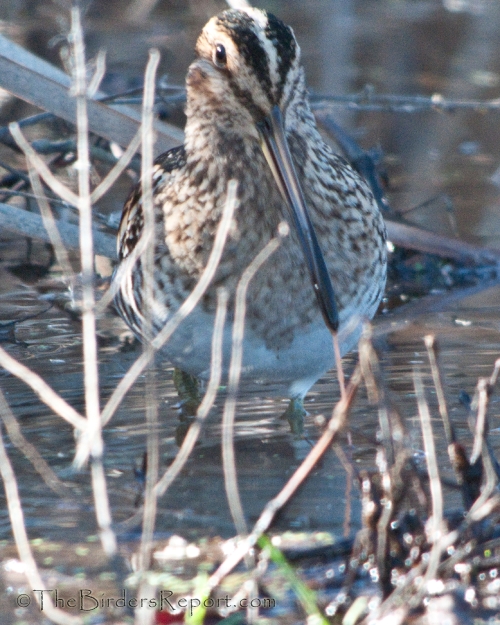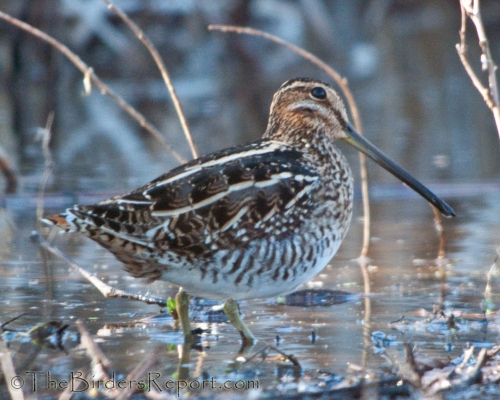Wilson’s Snipe Sitting On A Post photos by Larry Jordan
According to Wikipedia, a snipe hunt is “a form of wild-goose chase that is also known as a fool’s errand, a type of practical joke that involves experienced people making fun of credulous newcomers by giving them an impossible or imaginary task. The origin of the term is a practical joke where inexperienced campers are told about a bird or animal called the snipe as well as a usually preposterous method of catching it, such as running around the woods carrying a bag or making strange noises such as banging rocks together. Incidentally, the snipe (a family of shorebirds) is difficult to catch for experienced hunters, so much so that the word “sniper” is derived from it to refer to anyone skilled enough to shoot one.”
Fortunately, the hunting of the real shorebird, Wilson’s Snipe, Gallinago delicata (previously considered a subspecies of Common Snipe), has declined over the years. “Harvests” of these little elusive birds (standing about 10 inches tall and weighing in at a tad over 3 ounces) has declined over the years from about 137,000 in 19921 to around 83,500 in 20092.
That still sounds like a lot of dead birds to me.
 I was hunting this bird with my camera and digiscoping setup when I found him at Lema Ranch, hanging out with a Long-billed Dowitcher. The dowitcher was out in the open but the Wilson’s Snipe was hiding in the bulrush. Finally, reluctantly, coming out to forage for invertebrates on the mudflats.
I was hunting this bird with my camera and digiscoping setup when I found him at Lema Ranch, hanging out with a Long-billed Dowitcher. The dowitcher was out in the open but the Wilson’s Snipe was hiding in the bulrush. Finally, reluctantly, coming out to forage for invertebrates on the mudflats.
These wading birds have a long bill with sensory “pits” near the tip allowing them to detect prey by touch as they probe the mud. They also have eyes that are set well back on their head providing full vision to both sides and a binocular overlap to the rear. This arrangement enables a bird to detect the approach of a predator while its beak is fully buried in the mud1.
These attributes seem to allow for very successful foraging as you can see in this photo. This bird extracting what appears to be a worm.
Snipes also do this interesting bobbing thing and stamp their feet occasionally, apparently to startle prey into moving. I caught a bit of it on video. Notice the call of the Red-shouldered Hawk as well as the Canada Goose during the video.
As the Red-shouldered Hawk flew over, the snipe looked up, making sure he wasn’t on the hawk’s menu.
One of the things Wilson’s Snipes are famous for is their winnowing flights (which I would love to witness). These are performed primarily at the beginning of breeding season and usually occur in the evening1. They use these flights to establish and maintain breeding territories, among other things.
This winnowing sound is produced by air flowing over the bird’s outstretched tail feathers.
[audio:https://thebirdersreport.com/audio/WilsonsSnipe.mp3] Sound credit to Andrew Spencer, file XC14873, Courtesy of Xeno-Canto3
Pretty cool if you ask me! I plan on seeking out some Wilson’s Snipe breeding grounds next season to see if I can witness this phenomenon. These birds can reach speeds of up to 60 mph!
For more great bird photos, check out Bird Photography Weekly.
References: 1 Birds of North America Online , 2 U.S. Fish & Wildlife Service, Migratory Bird Hunting Activity and Harvest During the 2008 and 2009 Hunting Seasons, 3 Xeno -Canto, file XC14873














Comments on this entry are closed.
Great photos of this elusive bird, Larry. I especially like the photo where you have caught the snipe pulling out a worm. The Latham’s Snipe visits this part of Australia but I have only seen one a couple of times.
Great shots and Video! Got a kick out of the video..this round body bobbing with its tiny little head and long bill.. cute!
Excellent, Larry!
Congratulations on your successful snipe hunt. Wonderful images.
great shots! And I enjoed the video and the winnowing sound .
I hope they stop hunting them all together.
@Mick thanks. That shot of the bird pulling out the worm I discovered after downloading the images. Their movements while they’re foraging are so quick, it is hard to pick up the details while watching them in real time.
@Dawn it was rather comical watching him bob up and down
@Klaus thanks!
@Bill thank you very much. I’m glad you stopped by giving me the link to your site. You have some incredible images there and I love your videos too! Your photo of the Brown Creeper is the best I’ve ever seen!
@NF thank you. I agree with you on the hunting issue
Wonderful photos of the Wilson’s Snipe. They are so hard to photograph. I find them regularly over at our VOA park, but they never hang around for photo ops! I love the last photo of the bird looking up to eye the hawk…very cool.
Nice shots! My ex had a bird book that had a drawing of a snipe & chicks in it, which lead me to create a band in my head; Common Snipe and the Chicks. It was a cute drawing, though.
I’ve heard one doing a winnowing flight, but it was too dark to see it, unfortunately. If it’s anything like a woodcock’s display flight, it would definitely be worth seeing.
@Kelly this bird stayed out in the open for quite some time. He (or she) would dart back into cover if he felt threatened but after awhile, he would come back out. I like that last shot too just because I was getting ready to look up to see the RSHA when the snipe looked up
@Lana I kinda like Snipe and the Chicks 😉
@Grant I understand that it is much like the woodcock display. They are close relatives of the woodcock. Also, love your story of the Clapper Rail that came out to pose for the crowd
Excellent post and images Larry. Enjoyed the video and the bouncing action which reminded me of our Jack Snipe, smaller than Common with much shorter bill, and very secretive.
I remember a Cheers episode when the gang took Frasier on a snipe hunt. Great find!
Another of your informative posts with excellent pictures Larry. Apprentices in the building trade in the Uk were often sent to the merchants to buy some “sky hooks” but never came back with any.
Love the trivia about origin of the word “sniper.” Never would have guessed.
Once, years ago and before I started birding, I swear I saw a bird like this in my front landscape bed. I remember, because I had never seen a bird with such a long bill. I just checked their range and see they are in my area during winter. Hmmm, maybe it was just passing through on its way to a pond.
Great post, Larry. Interesting stuff you put together. Thanks.